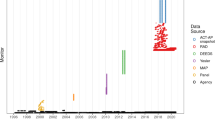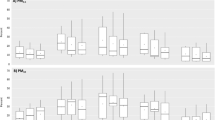Abstract
We modeled the intraurban distribution of nitrogen dioxide (NO2), a marker for traffic pollution, with land use regression, a promising new exposure classification technique. We deployed diffusion tubes to measure NO2 levels at 39 locations in the fall of 2003 in San Diego County, CA, USA. At each sample location, we constructed circular buffers in a geographic information system and captured information on roads, traffic flow, land use, population and housing. Using multiple linear regression, we were able to predict 79% of the variation in NO2 levels with four variables: traffic density within 40–300 m of the sampling location, traffic density within 300–1000 m, length of road within 40 m and distance to the Pacific coast. Applying this model to validation samples showed that the model predicted NO2 levels within, on average, 2.1 p.p.b for 12 training sites initially excluded from the model.Our evaluation of this land use regression model showed that this method had excellent prediction and robustness in a North American context. These models may be useful tools in evaluating health effects of long-term exposure to traffic-related pollution.
This is a preview of subscription content, access via your institution
Access options
Subscribe to this journal
Receive 6 print issues and online access
$259.00 per year
only $43.17 per issue
Buy this article
- Purchase on Springer Link
- Instant access to full article PDF
Prices may be subject to local taxes which are calculated during checkout




Similar content being viewed by others
References
Brauer M., Hoek G., van Vliet P, et al. Estimating long-term average particulate air pollution concentrations: application of traffic indicators and geographic information systems. Epidemiology 2003: 14: 228–239.
Briggs D.J., Collins S., Elliott P., et al. Mapping urban air pollution using GIS: a regression-based approach. Int J Geogr Inform Sci 1997: 11: 699–718.
Briggs D.J., de Hoogh C., Guiliver J., et al. A regression-based method for mapping traffic-related air pollution: application and testing in four contrasting urban environments. Sci Total Environ 2000: 253: 151–167.
Brunekreef B., and Holgate S.T. Air pollution and health. Lancet 2002: 360: 1233–1242.
English P., Neutra R., Scalf R., et al. Examining associations between childhood asthma and traffic flow using a geographic information system. Environ Health Perspect 1999: 107: 761–767.
Finkelstein M.M., Jerrett M., DeLuca P., et al. Relation between income, air pollution and mortality: a cohort study. Can Med Assoc J 2003: 169: 397–402.
Finkelstein M.M., Jerrett M., and Sears M.R. Traffic air pollution and mortality rate advancement periods. Am J Epidemiol 2004: 160: 173–177.
Hoek G., Brunekreef B., Goldbohm S., et al. Association between mortality and indicators of traffic-related air pollution in the Netherlands: a cohort study. Lancet 2002: 360: 1203–1209.
Jerrett M., Arain A., and Kanaroglou P. A review and evaluation of intra-urban air pollution exposure models. J Exposure Anal Environ Epidemiol 2005: 15: 185–204.
Jerrett M., Arain A., Kanaroglou P., et al. Modelling the intra-urban variability of ambient traffic pollution in Toronto, Canada, in press.
Krewski D., Burnett R.T., Goldberg D.E., et al. Reanalysis of the Harvard Six-Cities Study and the American Cancer Society of Air Pollution and Mortality, Phase II: Sensitivity Analysis. Health Effects Institute, Cambridge, MA, 2000.
National Research Council. Estimating Public Health Benefits of Proposed Air Pollution Regulations. National Academy Press, Washington, DC, 2002.
Palmes E., Gunnison A., Dimattio J, et al. Personal sampling for nitrogen dioxide. Am Ind Hyg Assoc J 1976: 37: 570–577.
Pope C.A., Burnett R.T., Thun M.J., et al. Lung cancer, cardiopulmonary mortality, and long-term exposure to fine particulate air pollution. JAMA 2002: 287: 1132–1141.
Rijinders E., Janssen N., Van Vliet P., et al. Personal and outdoor concentrations in relation to degree of urbanization and traffic density. Environ Health Perspect 2001: 109: 411–417.
SANDAG. SANDAG GIS Metadata: Current Landuse, 2004: http://www.sandag.cog.ca.us/resources/maps_and_gis/gis_downloads/downloads/metadata/ludoc.htm. Accessed 2004.
United States Environmental Protection Agency (USEPA). National-Scale Air Toxics Assessment for 1996. Estimated Concentrations by Census Tract. Cumulative Exposure Project, 2001 Accessed.
Wilkinson P., Elliott P., Grundy C., et al. Case–control study of hospital admission with asthma in children aged 5–14 years: relation with road traffic in north west London. Thorax 1999: 54: 1070–1074.
Acknowledgements
This publication was supported by grant number 5-R21-CA094723-03 from the National Cancer Institute. Its contents are solely the responsibility of the authors and do not necessarily represent the official views of the National Cancer Institute. Dr. Jerrett's time was partly funded by grants number, 5P30 ES07048, 5P30 ES05605-14, 5P01 ES09581, and IP01 ES11627 from the National Institute of Environmental Health Sciences.
Author information
Authors and Affiliations
Corresponding author
Rights and permissions
About this article
Cite this article
Ross, Z., English, P., Scalf, R. et al. Nitrogen dioxide prediction in Southern California using land use regression modeling: potential for environmental health analyses. J Expo Sci Environ Epidemiol 16, 106–114 (2006). https://doi.org/10.1038/sj.jea.7500442
Received:
Accepted:
Published:
Issue Date:
DOI: https://doi.org/10.1038/sj.jea.7500442
Keywords
This article is cited by
-
The built environment and asthma: Los Angeles case study
Journal of Public Health (2023)
-
RETRACTED ARTICLE: Soil and water loss of mountain plants based on sensor and research on visual experience art
Arabian Journal of Geosciences (2021)
-
Assessment of contribution of SO2, CO, and NO2 in different urban land use in Bushehr region, Iran
Arabian Journal of Geosciences (2021)
-
The effects of infrastructure development and carbon emissions on economic growth
Environmental Science and Pollution Research (2021)
-
Development of model for sustainable nitrogen dioxide prediction using neuronal networks
International Journal of Environmental Science and Technology (2020)



